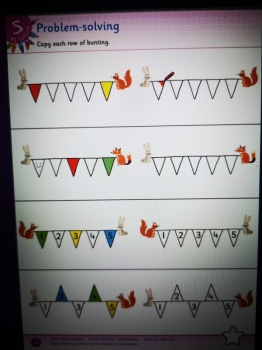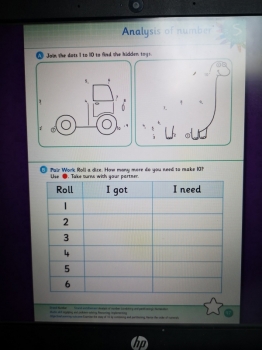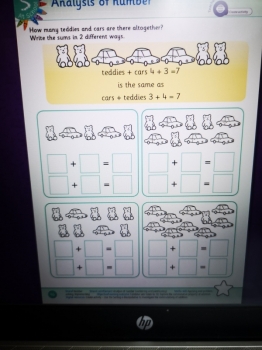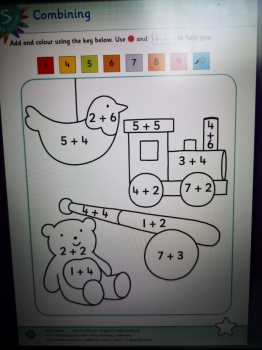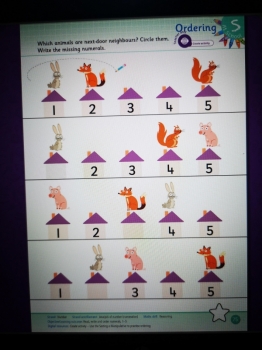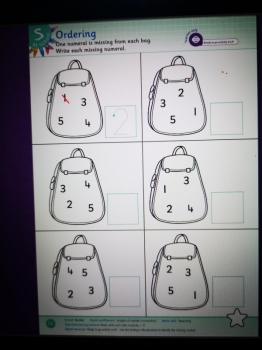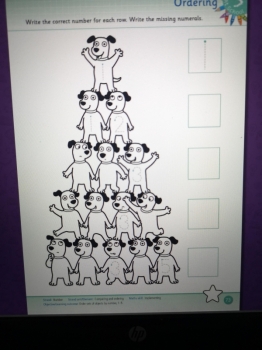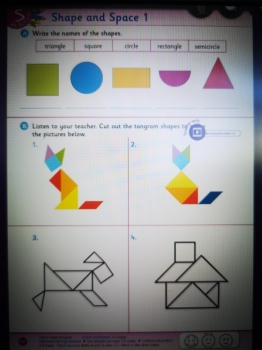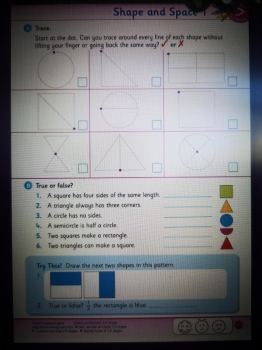Miss Casey
Monday 27th April -1st May
Hi everyone, week 2 back after Easter. I hope you are all well. I am missing you all. I hope you can get outside and you are playing lots. Here you will find some work to keep you busy!
I have uploaded all of the maths for the week and I will upload the literacy daily.
Hope it's ok, let me know if you need anything.
Hope to see you soon, Keep safe,
Miss.Casey
Junior and Senior infants:
Literacy
Wednesday: phonics
Same as Monday but with sound ue
Story:
It is Samuel’s birthday, and he is having a party. First, Samuel and his friends play musical chairs. After that, a magician performs a magic show; he is very amusing. He uses a magic wand and he has a big magic box with a unicorn on the side. He does a few card tricks, and then he asks for someone to come and help him. “You!” he says, pointing at Samuel, “You are the birthday boy”, he continues, “will you come and help me?” “Me?” asks Samuel. “You!” shout the children. Samuel helps the magician do a special trick. He has to wave the magic wand and say, “ue, ue, ue.” Right on cue, a rabbit pops out from under the magician’s table! After the magic show, they all go outside and have a barbecue.
Blending words:ue words:
blue
glue
fuel
clue
argue
rescue
Tuesday: Oral language and handwriting
Lesson 2
On Tuesday and Thursday we some some oral language before we do our other work.
Last week you should have tried lesson 1. This week try lesson 2 on Tuesday and 3 on Thursday. Lesson plan is attached below.
The poster is on folens website, if the link below doesn't bring you to the poster...Once you log in, search starlight junior infants..click resources and search supermarket.
Not all of this has to be covered...pick and choose
Digital poster (Story mode): Recap LO 1
Play either the Story mode 1 (starters) or Story mode 2 (flyers) for the children again. Make sure they understand all of the vocabulary.
Digital poster (Question mode) LO 8, 9, 13, 14
Go to the Question mode of the poster. Listen to each question and discuss the answers with the children briefly.
|
Q1. |
What kind of shop is this? |
|
Q2. |
What fruit can you see in the fruit and vegetables section? |
|
Q3. |
Who is standing at the checkout? |
|
Q4. |
How many items are on the shopping list? |
|
Q5. |
What kind of food do you find in the dairy section of a supermarket? |
|
Q6. |
If you had a big shopping list, would you use a basket or a trolley? |
|
Q7. |
Why is it a good idea to make a shopping list before you go shopping? |
|
Q8. |
Why is the dairy section kept at a cool temperature? |
|
Q9. |
What other things can you find in a supermarket? |
|
Q10. |
Would you like to work in a supermarket? Why? |
Make a list LO 1, 2, 3, 5, 6
Play the story At the Supermarket by Ann Rockwell for the class (https://www.youtube.com/watch?v=40bE0gKpcYI). Ask children the following questions:
- Can you remember the groceries the family bought? (meat: chicken, hamburger, pork chops; vegetables: onions, lettuce, carrots, potatoes; fruit: grapes, oranges, apples; bread; peanut butter; dairy: milk, butter, eggs, cheese; laundry soap; dish soap; toilet paper; kitchen paper; paper napkins; coffee; tea)
- What special groceries did they buy? (ingredients for a birthday cake: flour, sugar, baking powder, vanilla, candleholders and candles, sugar sprinkles)
Make a shopping list
Ask children to look at the list of groceries on the poster and identify when/for what meals we would eat the foods listed (e.g. we eat potatoes for dinner, we put milk on our cereal at breakfast time, etc.)
Have children make their own shopping lists for foods we eat for breakfast/lunch/dinner. Where would we find these foods in the supermarket? (dairy aisle, fruit and vegetable aisle, etc.)
Next, have children make their own shopping lists for foods/items we need from the supermarket for a birthday party/barbecue/baby/to make a sandwich/for a pet, etc.
Pair talking task: Check it Twice! LO 2, 3
Organise the children in pairs. Model the activity for children first by reading the following:
Listen to my list. Which food does not belong?
Cereal, milk, ice-cream, orange juice.
(ice-cream does not belong because it is not a breakfast food)
Chicken nuggets, bread, cheese, ham
(chicken nuggets do not belong because they are not a lunch food)
Burgers, chips, beans, yoghurt
(yoghurt does not belong because it is not a dinner food)
Encourage the children to take turns making up their own lists, each including one food item that does not belong, and tell them to their partners. Once their partners have identified the odd item out, children swap roles and repeat.
Supermarket Workout LO 7
Call out the actions listed below. Encourage children to repeat the actions while miming the movement.
Pull (the trolley)
Push (the trolley)
Turn (the trolley round)
Reach for (the cereal packet)
Stretch for (the tin of beans)
Lift (the bag of potatoes)
Squat down low (for the box of teabags)
Pack (the groceries into bags)
Carry (the bag of groceries)
Lesson 3
Digital poster (Explore mode): Talk and discussion LO 5, 6, 13
Go to the Explore mode with the children again. Direct children to look at the poster and listen to the following sentences. After each sentence, ask: Is this true or false? Why?
True or false
- There are three bottles of potatoes in the vegetable section.
- There is a picture of a cow on the carton of orange juice.
- There are six eggs in each egg carton.
- There are strawberry yoghurts in the dairy fridge.
- The customer is buying steaks.
- There are frozen peas in the bakery section.
- There is a long queue at the checkout counter.
Digital poster: (Activity mode) Supermarket sorting LO 2, 7, 10, 13
Go to the Activity mode of the poster. Play the sorting activity. Ask children to identify which section of the supermarket each food item belongs in.
|
Dairy section |
Milk, yoghurt, cheese |
|
Fruit and veg section |
Carrots, bananas, lemons |
|
Fish section |
Fish, lobster, salmon |
Food Tongue Twister LO 12
Organise children in groups. Have each group choose a tongue twister from the list below and practice chanting it quickly.
How many cookies could a good cook cook if a good cook could cook cookies?
Betty bought some butter but the butter Betty bought was bitter.
Red lolly, yellow lolly
A proper cup of coffee from a proper copper coffee pot
I bought a big basket of mixed biscuits from the bakery
One fish, two fish, red fish, blue fish
Please pay promptly!
What would you do if …? LO 4, 5, 6, 13
Have children to complete the following sentences examining manners and etiquette in a supermarket setting.
- If I got lost in a supermarket, I would …
- If I found a (wallet, handbag, lost ring, etc.) in the supermarket, I would …
- If I broke (a bottle of milk, a carton of eggs, a glass door) in the supermarket, I would …
Verbs: talk to; ask for help; return; apologise; remember for next time, etc.
We usually do our handwriting book on Tuesdays-Now you have your books you can do 1 -2 pages per week. There are also games online you can do to support the writing.
Link below Juniors are A Seniors are B
Lets continue with two letters t, p
Monday:Phonics
(Find actions for all sounds below in link)
5. Think of some oi words together.
coin
soil
foil
boil
point
spoil
poison
7.Senior infants can try and think of some of their own oi words and write them. Spelling isn't corrected here. It's for the children to think of the oi sound and use their phonetic knowledge to sound out a word. Try and write a couple.
Click start, phase 3 and click oi sound.
Other sounds may be practised too.
Parents can help read the word and allow the children to decide if its real or fake.
This can be done with paper and two bundles; real or fake too, without having to use online version.
Junior Infants
Page 77:. Make a story about the activity, e.g. Once upon a time, there was a little ladybird sitting on a leaf. She was lonely and wanted a friend. Along came another ladybird and now she’s not lonely anymore. Now there are two ladybirds. Draw the children’s attention to how this is depicted: the words and and make and the frames for writing each number. Ask individual children to make up stories about the other animals (birds, worms, frogs and fish).
Page 79: Demonstrate this activity using your fingers (or ask the children to help you). Some children may already be using their fingers to count, so this is an opportunity to ensure that they are doing so correctly.
Page 28: This is an opportunity for the children to practise combining sets and recording their answers.
Senior Infants
Maths:
pgs 99-101
● parts A and b: The children identify if objects are full, empty, nearly full or nearly empty.
● part c: Point to the first set of pictures. Ask the children questions, e.g. What container holds more? How do you know? The children colour the container that holds more in each pair of pictures.
page 31: The children are learning to use vocabulary relating to capacity.
First class
1ST CLASS MATHS
This week 1st class will be doing Operation Maths ,chapter 42,pages 108-113.
Page 108-109
Please encourage your child to use cubes to do these sums.Your child could also use a 100 square to complete these sums.
Page110 and page 111
Use cubes to do these sums.A 100 square would also be helpful.
Your child might find these sums easier to do if they were written downwards as in exercise D page 110.Remember to put T and U (tens and units)on top of each sum.
Page 112 and 113.
Again ,these sums could be written downwards ,for example,
T U
1 9
-0 2
It is important to remind your child that he/she must always start with the units.Also,remind your child to start at the top of the units,for example ,
9 take away 2 is
Then go to the tens side and say 1 take away 0 is
Page 113.
B:Remind children to always look at the sign before doing the sum.
C:Please discuss each problem orally with your child.
Blue box at bottom of page-your child could use a 100 square to help him/her fill in the correct numbers.
Tables-Revision of plus 5.
Master Your Maths-Please continue as usual with your work in this book.
1ST CLASS LITERACY
first class pupils are working on chapter 5b in their Starlight books-Waiter,there`s a dog in my Soup,pages 42-45.
Read the poem by Kenn Nesbitt three times with your child.Ask questions on the poem -Do you like this poem?Would you like it if there was a fly/wasp in your soup?
Discuss the focus word.Put them into sentences(orally).
Page 43
A:Answer the questions-use full stops,capital letters and full sentences.Or,your child can answer these questions orally.
B:Circle the word.Please go over this section before your child chooses the most suitable word for each sentence.
Page 44.
A and B:Explain to your child the difference between....to,two and too.Go over the exercises orally before your child writes the answers down.
Page 45.
Please explain to your child what a cinquain is,before your child writes a cinquain about an animal/their favourite person.
Pupils can compose more cinquains-use your own ideas or use the ideas in the blue box,at the bottom of page 45.
Pupils can also write their daily news/diary.Remind your child to use full stops,capital letters and full,short,sentences
Monday April 20th-Friday 24th
Junior and Senior Infants:
Literacy:
Friday: 24th April
On Fridays we do some dictation.
Juniors: I say letters, slowly, a few times, children write them down. Say the name of the letter and the sound.
If you feel your child is able, try some small 3 letter words. Saying the word, then each sound slowly and the word again.
sat
ran
mam
dog
tip
Senior Infants can begin by writing small words as above and then try some harder words: we usual write 10 in total
ship
chop
sail
card
lamps
sheet
starfish
lipstick
Thursday 23rd April
Free Writing
On Thursday we do free writing. We spend some time talking about what we could write. I model some sentences for the children to see what the writing should look like, capital letter, spaces, letters sitting or hanging on the line.
The children can write whatever they wish. It can be words, letters, names, sentences, a story, or words they see in the room and a picture. This writing isn't corrected. It allows the children to write freely, make mistakes and encourage them to use their knowledge of phonics to help themselves write.
Wednesday 22nd April
Children can cover the new sound ou.
-after reading, ask; did you hear any ou sounds? or read again and say put up your hand if you hear a ou sound while I read
Tuesday 21st April
On Tuesdays we usually do our oral language poster lesson 1. https://content.folensonline.ie/programmes/Starlight/JI/resources/posters/SL_JI_ACT_CH14_005/index.html
You can cover some..or all of this!
Digital poster Story:
Play either the Story mode 1 (starters) or Story mode 2 (flyers) for the class, depending on the ability level.
Digital poster (Explore mode): Talk and discussion
Go to the Explore mode of the poster. Ask the children the following questions:
- Where do we go when we are shopping for food? (Supermarket).
- A supermarket is a place that sells lots of different kinds of food for us to eat. What do we call the food we buy in a supermarket? (Groceries).
- What does a supermarket look like? (It has lots of These are separated by long passages called aisles).
- What do we use to carry our groceries in a supermarket? (A basket/trolley).
Zoom in on each section of the poster in turn – Fruit and Vegetable; Bakery; Breakfast Cereal; Dairy; Meat; Fish; Frozen Foods. Ask children the following questions about each section:
- What food can you see in this section of the supermarket?
- What is this section called?
Encourage the children to name as many of the food items as possible in each section. Introduce any unfamiliar items. Talk about size, shape, colour and texture. Talk about what meal we eat these foods at/what we eat them with. Encourage children to express preferences (my favourite … I like/dislike… etc).
Help the children to sort the foods we buy in the supermarket by their characteristic features, e.g. name a food that you peel/spread on bread/is yellow/is crunchy/has pips in it/you eat with a spoon/you must cook before you eat it/is spicy/is sweet, etc.
Help the children to sort the foods we buy in the supermarket by packaging, e.g. a can of/a bottle of/a pot of/a jar of/a box of/a tin of/a packet of/a carton of/a bunch of/ a head of/a dozen of, etc.
Next, focus on the checkout area of the poster. Ask the children the following questions:
- Who works at the checkout? (the sales assistant)
- How do we know this person works in the supermarket? (She is wearing an apron/uniform and has a name tag)
- What do we call the person who is buying the groceries? (Customer)
- When do we use a basket/trolley in the supermarket? (When we have a few/lots of groceries)
- Where do we put our groceries when we are checking out? (On the conveyor belt)
- What does the sales assistant do when we are checking out? (Scans the barcode to check the price)
- What is the till used for? (to take the money for the groceries)
- How do we pay for the groceries (with cash or with a card, using the card machine)
- Where do we put our groceries after we have paid for them? (in our shopping bags)
Synonyms – buy, purchase
Compound words – supermarket, breakfast, strawberry, pancake, pineapple, peanut, popcorn
After our oral language we do our handwriting;
We usually do our handwriting book,you can look at this here and do games online.http://data.cjfallon.ie/resources/gwtf-handwriting/index.html#!/books Juniors are A Seniors are B
Or we can start revision of the letters, writing in pencil, crayon, markers, big or small letters, on a page or using your fingers in sand, flour etc.
Lets start with two letters s and a
Monday
Phonics:
Children can cover the new sound qu.
(Find actions for all sounds below in link)
-after reading, ask; did you hear any qu sounds? or read again and say put up your hand if you hear a qu sound while I read.
quit
quick
quack
Tricky words: Juniors would have been covering the red tricky words and also revising the blue and yellow.
Seniors and first class need to revise all.
Blue- 1-12 Yellow 13-24 Red 25-36
Green 37-48 Pink 49-60 Brown 61-72
https://content-jollyphonicsuk.cpdcollege.com/media/pdf/GrHndbk_Br_trickywords.pdf
You can also continue to do...
- Days of the week- What day is it today/ tomorrow/ yesterday. How many days in the week/weekend? https://www.youtube.com/watch?v=mXMofxtDPUQ
- Months of the year- What month is it, what is next/last month, in what month is Halloween, Christmas etc. https://www.youtube.com/watch?v=v608v42dKeI
- The seasons- What season is it? What was previous/next.. https://www.youtube.com/watch?v=8ZjpI6fgYSY
Maths
Username: primaryedcobooks
Password: edco2020
Junior Infants:
For the week: pgs73-76
Please complete these pages 73-76, as you are able, over the week.
Page 74:. Encourage the children to count (some will do so in their heads) to find out which number is missing. They are reinforcing their understanding of ordering number.
Page 75: Some children are more than capable of reciting the sequence of numbers but are unsure of what the position of each number actually means. This activity reinforces the concept of, for example, 2 and 3 being next to one another (only one step away), while 2 and 5 are three steps away.
Page 76: This activity explores the language of ordinal number, ordering of number, colour, shape, pattern and spatial relations. The children need to examine the first line of bunting in each row very closely in order to replicate it on the other side. Ask: Which numbers are up? Which numbers are down? Which number is yellow? Which number is missing?
Senior Infants:
Part A: Point to the first ten frame. How many red counters are there? How many purple counters are there? How many green counters are there? How many counters are there altogether? Ask the children to identify which sum is shown on the ten frame.
Part B: Point to the first sum. How many red counters should go in the ten frame? How
many blue counters should go in the frame? How many green counters should go in the frame? How many counters are there altogether?
page 96:
Point to the first sum. How many teddies are there? How many cars are there? Ask the children what ways the sum can be written, e.g. 3 + 2 = 5 or 2 + 3 = 5.
page 97:
Part A: The children join the dots 1 to 10 to find the hidden toys.
Part B: Distribute counters and one dice to each pair. Each child rolls a dice. They identify and write how many more they need to reach 10.
Number rhymes:
Number 1 is big and tall stand him/her up so she/he wont fall
Number 2 backwards and along just make sure you dont go wrong.
Number 3 two little curls, one for you, one for me.
Number 4 down and over and down once more that how we make the number 4
Number 5 is a funny chap, down fat belly with a hat.
Number 6 looks like a curl in your hair, twiddle it around to show that its there.
Number 7 starts with a hat, then goes down just like that.
Number 8 makes an s then goes back to join it up.
Number 9 is like a ball on a stick, start with a C then go up and down quick.
Number 10 is a hero, first the one then a zero!
First Class:
1st Class-Maths
This week the children will be working on Operation Maths-1st class-At School Book. Please log into www.edcoleanring.ie if you cant access this the pages are below to view.
They will do pages 106-107.Shape and Space.
A lot of discussion is needed for shape and space.Ask your child to find different shapes in your house.For example,you could ask what shape is the door/table/football/jar of jam/tin of beans/packet of digestive biscuits etc.Ask you child can different items/shapes stack or roll.Ask your child how many faces has a particular shape.Ask your child how many corners/edges on a football/pringles container/tin of beans/a table.
Your child could make a shape picture and colour it in.
page 106, Question a: Discuss the names of the shapes with the children, what can you think of in the world that are these shapes? Can you see any around you?.
page 106, Question b: Shapes can be cut out to make these if you can. (page attached) Make several attempts at manipulating the pieces into the cat shape. Use the vocabulary: slide, flip, rotate, try again. Stress that all seven tangram pieces must be used.
page 107, Question a: Model an example that allows you to make a ‘mistake’ by lifting your finger. Elicit from the children how the task might otherwise be done. Allow the children to work independently. Observe, discuss and assess their fine motor skills and their recall of the names of the shapes.
page 107, Question b: Children will need the sentence read to them, they can right t or f or place a tick or an x.
page 107, try this!
Tables this week-plus 4.
........................................................................................................
Please continue ,as usual,doing your Master Your Maths book.
.....................................................................................................
1st Class-Literacy.
You need to log in to the folens website to access Starlight.
Go to folensonline.ie.Register as a teacher.Roll number,use code-Prim20.
This week your child will be doing chapter 5a ,When The Giant Comes To Tea,in Starlight-Combined Reading And Skills Book.
Please read the text on page 38 a few times with your child.
Please read the focus words on the bottom of page 38.Discuss them with your child and make sentences,orally using these words.
On page 39,when your child is answering the questions ,encourage him/her to use capital letters and full stops.
On page 39 B-please discuss orally before your child writes the sentences down.
On page 40,explain the words-there and they`re.Think of lots of examples where you would use these words.
On page 41,please discuss a cinquain with your child.Help your child write a cinquin about a teacher.Your child could also write a cinquain about hie/her time being off school.
Please continue with writing 5 sentences and a picture of your daily news.
............................................................................................
Keep up the literacy games with your child-I spy.Hangman.What is the missing word?....remove a word from a group of flashcard

